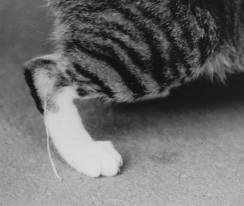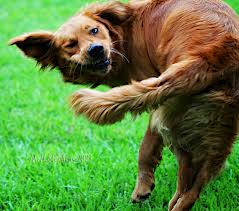14-Year-Old Pet Product Inventor
Brooke Martin, iCPooch
 Brooke Martin was only 14 when she invented the "iCPooch," a device that allows you to have visual contact between you and your dog using a tablet or mobile phone. It also dispenses treats. Brooke believes this is an answer to separation anxiety.
Brooke Martin was only 14 when she invented the "iCPooch," a device that allows you to have visual contact between you and your dog using a tablet or mobile phone. It also dispenses treats. Brooke believes this is an answer to separation anxiety.
The IC Pooch allows you to video-chat with your dog and deliver a treat to them remotely. While you are away from home, whether you are at work or on vacation, you can go on your smartphone, tablet or computer and call up your dog with a two-way video-chat. This means you can see and hear your dog and he can see and hear you. Then, if you'd like, you can dispense a treat to your dog with a push of a button.
But can your dog truly see your picture on a screen or television? Brooke hears this question all of the time and states that, "There have been several studies that show dogs can see an LCD screen."
Brooke invented iCPooch as part of an 8th grade class project when she was 12 years old. Even though it is her first invention, she states that, "I've always been an entrepreneur at heart!" She was inspired by her wish to stay connected to her beloved Golden Retriever Kayla, and to alleviate Kayla's separation anxiety. Brooke is now able to give Kayla commands where she will sit or lay down and wait for a treat.
Brooks tell us that even when she is home, Kayla will go to the iCPooch and lay down, staring at it, waiting for a treat.
Brooke earned a spot as a top-10 finalist in the national Discovery Education 3M Young Scientist Challenge (www.youngscientistchallenge.com) and ultimately the title of 1st runner up in "America's Top Young Scientist" competition. This is a challenge for kids grades 5 through 8. Kids all over the United States enter a one to two minute video, discussing an invention or idea they have. Brooke decided to enter, as she felt it would be a lot of fun.
Winning this competition allowed Brooke to work with a 3M Scientist to help her test and develop her idea. Brooke also flew to St. Paul, Minnesota, to the 3M Innovation Center, where she competed with the 9 other finalists and took 2nd place.
New Worm Threat To Cats
Araceli Lucio-Forster, Cornell University
 Imagine a 6-inch worm coming out of your cat's skin. Sounds like something out of the latest horror movie. Unfortunately, it's a real new worm that poses a threat to your cats. Parasitologist Araceli Lucio-Forster explains this new discovery.
Imagine a 6-inch worm coming out of your cat's skin. Sounds like something out of the latest horror movie. Unfortunately, it's a real new worm that poses a threat to your cats. Parasitologist Araceli Lucio-Forster explains this new discovery.
Araceli Lucio-Forster studies parasites, their hosts and the relationship between them, at Cornell University. She spends most of her time teaching veterinarian students about parasites.
When Cornell University veterinarians found half-foot-long worms living in their feline patients, they had discovered something new.
However, the group of Dracunculus insignis worms is not new at all. It is also called the guinea worm, which affects people when they drink water that contains water fleas infected with guinea worm larvae. They are seen more frequently in Africa and South Asia. But since 1986, where the Carter Foundation started their eradication programs, it is much less prevalent.
Nevertheless, their sister worm which has now been found in cats, is the first time it has been seen in cats.
 These worms, which can grow to almost a foot long, actually have to come out of the skin. They form a blister-like protrusion in an extremity, such as a leg, from which they slowly emerge over the course of days to deposit their young into fresh water.
These worms, which can grow to almost a foot long, actually have to come out of the skin. They form a blister-like protrusion in an extremity, such as a leg, from which they slowly emerge over the course of days to deposit their young into fresh water.
Those then turn into shrimp-like crustaceans, where they mature. If they do mature, and they are ingested by, for example, a raccoon, a cat or a human, then that host would become infected with the worm.
While the Dracunculus insignis worms are not fatal, the problem is that you have a worm, about a foot long, which can take a good amount of time to fully emerge from their host. They essentially create this open sore that can remain for quite some time.
You will normally not even know if your pet has this worm until it actually starts to emerge. They may have a bump, instead of a worm actually emerging, which can be surgically removed, as there is no medication to treat them.
Visit Website
My Bionic Pet
Jennifer Robinson, Westcoast Brace & Limb
 Amputee Jennifer Robinson worked at a prosthetic manufacturer for many years. Now, she's showing off how artificial limbs are being used on dogs, cats, birds and even sea-life.
Amputee Jennifer Robinson worked at a prosthetic manufacturer for many years. Now, she's showing off how artificial limbs are being used on dogs, cats, birds and even sea-life.
Jennifer Robinson is a congenital above knee amputee who has been wearing a prosthetic since she was two years old. The birth defect has shaped her life and inspired her to help others. For more than a decade, Robinson worked at Westcoast Brace & Limb in Tampa helping recent amputees adjust to life with a prosthetic. While their stories were all different and their devices were different, the one thing that connected them was their ability to adapt and move on.
Besides human patients, there were many non-human patients at Westcoast Brace & Limb. Animals that have met with misfortune, whether from a birth defect, accident, disease or even human cruelty, are now getting a second chance at life due to human intervention and technological advances. Left disabled without limbs, fins, flippers, beaks or tails, these creatures face a grim future, if one at all. But innovative prosthetics can change those survival odds if someone comes to their rescue.
One such patient was a dog named Journey, a golden retriever born without his front left paw. Jennifer had a close bond with him and often worked with Journey, who is a certified therapy dog, helping amputees adjust to life with prosthetics. The dog has also become a favorite visitor to patients at St. Joseph's Children Hospital, as well as veterans and the elderly.
Why do we put prosthetics on animals? Do we do it for us, because we feel better if our pets wears them, or does it actually make a difference to our pets? Jennifer feels it is a little bit of both. But she does state that Journey would not wear his limb if it didn't help him.
Journey wears his artificial limb every day, which makes it easy for him to get around. When it is taken off at night, Journey will sniff the prosthesis and lick and clean it.
Jennifer states that Darwinism is the survival of the fittest, but she feels it should be called "Survival of the creatures that can adapt the best!"
Buzzfeed Beastmaster
Jack Shepherd, Buzzfeed
 What the heck is a Beastmaster? Jack Shepard is a self-proclaimed Beastmaster at the Buzzfeed website. He gets paid to surf "animal related" fodder and make it go viral on the incredibly popular website.
What the heck is a Beastmaster? Jack Shepard is a self-proclaimed Beastmaster at the Buzzfeed website. He gets paid to surf "animal related" fodder and make it go viral on the incredibly popular website.
Jack Shepherd is the original Beastmaster at Buzzfeed (the fourteenth most read site on the Internet). So what is a Beastmaster? Beastmaster is actually a reference to a cult 80's movie. So when Jack needed a title, he liked the name and decided to call himself one. Now, Beastmasters are the guys who make those lists of animal pictures that clutter your twitter feed.
Do you like animals? Do you think they're the cutest things the Internet ever invented? Could you spend all your waking hours watching cat videos or, even better, working with a team of like-minded connoisseurs to determine which is objectively cuter - clips of a tiny jungle cat or of an impossibly adorable, very pettable wild hippo? Then there is a job out there for you - an actual paid profession created by and for the digital age. And there is a name for it, too. A pretty cool one, actually: You could be known as a Beastmaster.
Currently, there are three Beastmasters at Buzzfeed who do animal stuff. People on the Internet really seem to love animals, and particularly cats. The animal Beastmasters look for things that are uplifting and fun. Their motto is powered by cute.
The Beastmasters spend their days going through not only videos, but also pictures and stories about animals. Animals play such a big role in people's lives, and there is so much out there, Jack tells us that it is hard to sift through the stuff that is actually going to be interesting to a wide range of people.
While they go for the cute side of animals, they also try to keep it funny and interesting. Jack states that on the Internet, for some reason, people love sharing videos about cats in particular. Jack has been trying to figure out why this is so. His theory is that a dog is trying too hard and cats don't care if they impress you!
Visit Website
It's Not Doggie Asthma - It's a Reverse Sneeze - Dr. Debbie
 What dog owner hasn't heard that frightening sound that dogs make - part cough, part sneeze and often described as a dog being unable to catch his breath. But it really isn't asthma, or some kind of bone stuck in your dog's throat - it's a reverse sneeze. So before you panic and run into the veterinary office on emergency, ensure you know what a reverse sneeze is.
What dog owner hasn't heard that frightening sound that dogs make - part cough, part sneeze and often described as a dog being unable to catch his breath. But it really isn't asthma, or some kind of bone stuck in your dog's throat - it's a reverse sneeze. So before you panic and run into the veterinary office on emergency, ensure you know what a reverse sneeze is.
Meet the Reverse Sneeze
A reverse sneeze is a respiratory sound in a category all its own. Also known as a pharyngeal gag reflex or backwards sneeze, the reverse sneeze is a commonly observed respiratory sound in dogs, and less commonly in cats. While a true sneeze occurs on the exhale, the reverse sneeze occurs as the dog inhales. The result is a reverberating snorting, wheezing, episodic sound that lasts for a few seconds to a minute or two. A reverse sneeze is a completely harmless sound and dogs do not suffer any immediate health threat from these episodes.
How can you tell it's a reverse sneeze?
There is no easy explanation of the sound - you just have to hear it and you'll recognize it. Click to see and hear an example of a dog's reverse sneeze episode.
Part of my enjoyment on the weekly national radio program, Animal Radio, is describing the peculiar smells, sounds and essences of veterinary medicine with our listeners. On many an occasion when speaking to callers, I have re-created the sounds of reverse sneezing. I'm no Rich Little, but I do take pride in my impersonation of a canine reverse sneeze, which is admittedly better in person with the visuals to complement the throaty sound.
Characteristics of a dog displaying a reverse sneeze include:
- Vibrational coughing/wheezing sound
- Stiff, extended neck
- Facial grimace
- No discharge from nose
- Not followed by coughing or vomiting up material
- Not involving collapse episodes
- Animal is completely normal after event
What causes a reverse sneeze?
Some reverse sneeze episodes occur when a dog gets very excited or pulls against a leash. Brachycephalic breeds (short faced breeds) like Pugs and Boston terriers commonly display reverse sneezing due to their upper airway conformation.
 Allergies, respiratory infections, nasal mites, inhaled foreign bodies and masses can also trigger reverse sneezing. Dogs with inflammatory conditions such as lymphoplasmacytic rhinitis can also display bouts of reverse sneezing. And sometimes reverse sneezing occurs in the wee hours of the night, while a dog is sleeping, for no apparent reason. In fact, many veterinarians receive panicked phone calls at 2am from pet owners, concerned of impending asthma attacks or respiratory arrest, only to have it turn out just to be a typical case of reverse sneezing.
Allergies, respiratory infections, nasal mites, inhaled foreign bodies and masses can also trigger reverse sneezing. Dogs with inflammatory conditions such as lymphoplasmacytic rhinitis can also display bouts of reverse sneezing. And sometimes reverse sneezing occurs in the wee hours of the night, while a dog is sleeping, for no apparent reason. In fact, many veterinarians receive panicked phone calls at 2am from pet owners, concerned of impending asthma attacks or respiratory arrest, only to have it turn out just to be a typical case of reverse sneezing.
What to Do?
There is no required treatment for a reverse sneeze episode. However, I recommend stroking a dog's throat while gently speaking to him in a calm manner until the episode subsides. Some advocate closing/pinching the nostrils off, which forces a dog to swallow and curtails the reverse sneeze episode. Whatever the approach, reverse sneezing episodes are over within minutes, so no emergency treatment is indicated. Antihistamines may be prescribed to minimize reverse sneezing episodes.
When to Worry?
If all of a sudden your dog is having repeated bouts of reverse sneezing, evaluation by your veterinarian is indicated. Consult with your veterinarian if your dog is reverse sneezing along with other symptoms such as facial rubbing, nasal bleeding, nasal discharge, coughing, or significant sneezing episodes.
Nasal mites are a common cause of reverse sneezing and may be noted after a recent boarding visit, especially if multiple dogs in a household are involved. Nasal mite treatment is easily pursued with anti-parasite injections of ivermectin (or in collie breeds - the alternative Milbemycin.) If reverse sneezing is excessive and prolonged, the nasal and pharyngeal areas should be evaluated by a veterinarian through rhinoscopy - a procedure performed under anesthesia in which the nasal passages and pharyngeal areas are visualized with an endoscope, a micro camera. This is how foreign objects and masses are typically identified. In other cases, further tests may be needed including a CT scan or with biopsy samples from sinus passages.
Final Thought
The good news is that most of reverse sneezing episodes are harmless, and do not indicate any serious illness. Arm yourself with information by learning what a reverse sneeze looks like and you may save yourself an unwanted emergency veterinary visit over this peculiar but non-life threatening occurrence.
Featured veterinarian known as "Dr. Debbie" on national pet radio program, Animal Radio. Ebook author of "Yorkshire Terriers: How to Be Your Dog's Best Friend"; "Pugs: How to Be Your Dog's Best Friend"; "Mini Schnauzers: How to Be Your Dog's Best Friend"; and "Shih Tzu: How to Be Your Dog's Best Friend." Dr. Debbie's books.
Visit Website
Animal Radio News with Tammy Trujillo
 Dogs - Priceless!
Dogs - Priceless!
Most of us consider our pets as priceless, but if you had to put a price on your dog, would it be $2 million? That's how much a Tibetan Mastiff puppy sold for in China. The one-year-old 200-pounder was purchased by a property developer at what's called a 'luxury pet' fair. Tibetan Mastiffs have become a prized status symbol among wealthy Chinese and that has sent prices rocketing. One industry insider though says that breeders may be conspiring to push the dogs' prices up. If you've never seen a Tibetan Mastiff they are enormous and have thick, round manes that make them resemble big lions. Behavior wise, they are fiercely loyal to their people and very protective.
The Smaller, The Better
If you have a cat at home, you know what happens if you set an empty box on the floor. That's right, your cat immediately gets in it, no matter how big it is or isn't. There actually are some pretty smart reasons; smaller places are safer, especially when you're sleeping; cats like to be warm and smaller spots are cozier; since domestic cats are descendants of wild cats, they still instinctively select places that are easier to defend; and the smaller the spot, the easier it is to fend off intruders.
 Special Kitten Generates Excitement
Special Kitten Generates Excitement
There's a kitten generating a lot of excitement in Texas. A remote camera captured an image of an ocelot kitten in a South Texas wildlife refuge. Federal wildlife biologist Hilary Swarts says she and her colleagues were jumping up and down and screaming. There are fewer than 50 ocelots in the wild in the U.S. Swarts tells the San Antonio Express-News it's believed the kitten is female, which will add to the breeding stock.
What Kind Of Pet You Have Apparently Says A Lot About You
CareerBuilder.com sponsored an online survey looking for a connection between a person's pet and that person's profession, annual salary and level of job satisfaction. Among some of the results; CEO's are primarily dog owners; snake and reptile owners are among the highest paid workers, earning six-figure salaries; people who like their jobs generally have a bird at home; doctors, lab techs, personal caregivers and realtors tend to have cats as pets; and fish usually belonged to people working in the financial field or the hotel and leisure industries.
 Does Your Dog Have A Serious Tail-Chasing Session?
Does Your Dog Have A Serious Tail-Chasing Session?
Some dogs have a real fascination with their tails, which might not be anything to worry about. But then again, it might. Most of the time, it's simply your dog enjoying some exercise in a very pet-centric way. But if they keep on doing it, vets say it could also be a sign of an anal gland problem, flea allergic dermatitis or other medical issues. And in some dogs, it could actually be a sign of obsessive-compulsive disorder (OCD). You can check to see if it is, by noting whether you can distract your dog from a serious tail-chasing session. This could also have huge implications for people. Researchers have zeroed in on four genes that are connected to OCD in dogs. Now, if the same genes are found to be malfunctioning in the human version of the disorder, and some studies seem to indicate that they are, this could eventually lead scientists to develop better drugs to deal with the disorder.
 Listen to the entire Podcast of this show (#1093)
Listen to the entire Podcast of this show (#1093)





